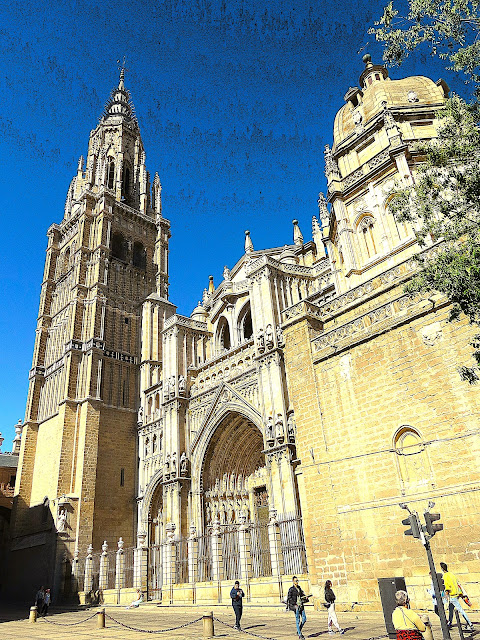El Greco is the reason I wanted to visit Toledo. I've always liked the unique way he elongated the subjects of his paintings, somehow stretching them to make them more real. I also was aware of a bit of Toledo's history and that it was once the capital of the Spanish kingdom (until 1561 when it moved to more accessible Madrid). I was not aware, however, that Toledo today is almost a suburb of Madrid. We met someone who works in Madrid but lives in Toledo, a half-hour train ride away.
We arrived in Toledo on Tuesday, May 14, near the end of our six-week spring 2024 trip to Spain. We took a train from Cordoba north to Madrid, and took another train south on a line that ends in Toledo, where we arrived at a delightful 19th-century station. The city itself, or at least the part tourists like us want to see, is a mountain-top fortress with narrow winding streets, shops selling Toledo-steel swords and suits of armor, an exceptional cathedral, plazas and great views of the landscape far below, including the Tajo River.
The taxi ride from the station up to our hotel involved so many twists and turns and extremely steep hills that I thought we'd never find our way around town on our own. But a smart phone's GPS and a map from our hotel, the Eugenia de Montijo, kept us from getting lost. In fact, there was a pretty straightforward route from the hotel to the cathedral plaza. The El Greco museum, which is housed in an older house remade to resemble a 16th-century house of El Greco's time, was also close, but in the opposite direction. More El Greco works can be seen at three places we didn't visit: Iglesio de Santo Tome, the Santa Cruz Museum, and the Museo Convento de Santa Domingo El Antiguo, where Domenikos Theotokopoulos (El Greco's real name) is entombed.
During our two-night stay here, we visited the El Greco museum (where we were admitted free), one of the city's two synagogue buildings, and the cathedral, and walked and walked through and around the town. When an aimless downhill walk took us well below the city walls, we were happy to stumble on a series of open-air escalators that returned us to the city center. Some of the shopping streets have awnings suspended between the tops of buildings to shade pedestrians from the sun.
In Toledo we finally perfected our strategy for lunch in Spain, a meal where most restaurants want you to order the menu de dia, a three-course meal, because lunch is traditionally the main meal of the day here. We found that some bakeries and some bars sell sandwiches, bocadillos, that are simply iberico ham in a crusty baguette. No mustard, no special sauce, no nothing. My nominee for best sandwich ever because the jamon iberico 100 (100% from a special breed of acorn-fed hogs) is just so good. This was also a lunch for us a day later when we returned to Madrid at the very end of our trip. We should have been doing this the entire time.
Here are some photos from Toledo:
 |
| The train station in Toledo. |
 |
| Much of Toledo looks like the set for a movie swordfight. |
 |
| Buildings from different eras merge in Toledo. |
 |
| This tower was near our hotel. |
 |
| A smart phone helped us navigate Toledo's old quarter. |
 |
| An awning suspended high above shields this shopping street from the sun. |
 |
| This arch at Zocodover Square leads to steps that go down to a row of tapas bars. |
 |
| Guides for walking tours try to find customers among the crowds of tourists at Zocodover Square. |
 |
| Stones structures from centuries past are everywhere in Toledo. |
 |
| Toledo is a city of museums. Besides this medieval warfare museum, there's a Manchego cheese museum. |
 |
| If you've been dying to see creative ways people were tortured and killed in the Middle Ages, Toledo is your town. |
 |
| Most of what tourists want to see in Toledo is within a compact and walkable area. |
 |
| Construction of the Toledo cathedral began in 1226 and was considered complete in 1493. |
 |
| This was in the crypt. |
 |
| Like most cathedrals in Spain, Toledo's is huge. |
 |
| This room in the cathedral has portraits of all of the city's bishops. |
 |
| Looking up into the cathedral's dome. |
 |
| The main altar displays the opulence that is seen in many cathedrals in Spain. |
 |
| The nativity is only a small section of the altarpiece. |
 |
| Madonna and child have a prominent place in the altar. |
 |
| The Synagogue El Transito is one of two surviving synagogue buildings in Toledo, which before 1492 had thriving and prosperous Jewish and Muslim communities. |
 |
| The decorative elements of the synagogue show the influence of Islamic design. |
 |
| The entrance to the El Greco Museum. |
 |
| The museum, built on the ruins of a Jewish quarter mansion, is meant to resemble the sort of house where El Greco might have lived in the 16th century. |
 |
| Saint James the Greater is among a series of El Greco's paintings of the apostles at the museum. |
 |
| This altarpiece, depicting Saint Bernadine the Greater, is the museum's most arresting work. El Greco designed the wooden surround to resemble a shrine. |


No comments:
Post a Comment